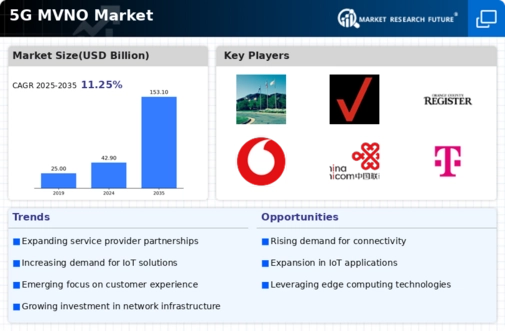Regulatory Support for MVNOs
Regulatory frameworks are increasingly supportive of MVNOs, which is a crucial driver for the 5G MVNO Market. Governments and regulatory bodies are recognizing the importance of MVNOs in promoting competition and enhancing consumer choice. Policies that facilitate easier market entry and reduce barriers for MVNOs are being implemented. This regulatory support is likely to encourage more entrepreneurs to enter the market, fostering innovation and diversity in service offerings. As a result, the 5G MVNO Market is expected to witness accelerated growth, with new entrants bringing fresh perspectives and solutions to the market.
Expansion of IoT Applications
The proliferation of IoT applications is a significant driver for the 5G MVNO Market. With the advent of smart cities, connected vehicles, and industrial automation, the need for reliable and high-speed connectivity is critical. The 5G technology facilitates the connection of millions of devices simultaneously, which is essential for the effective functioning of IoT ecosystems. Market data suggests that the number of connected IoT devices is expected to exceed 30 billion by 2025. MVNOs can capitalize on this trend by providing specialized services that cater to the unique requirements of IoT applications, thereby enhancing their service offerings and market presence.
Adoption of Flexible Pricing Models
The adoption of flexible pricing models is emerging as a key driver in the 5G MVNO Market. As consumers seek more personalized and cost-effective solutions, MVNOs are responding by offering a variety of pricing structures that cater to different usage patterns. This trend is particularly relevant in the context of 5G services, where consumers may require different data plans based on their connectivity needs. Market data indicates that MVNOs that implement innovative pricing strategies are likely to capture a larger share of the market. By providing options such as pay-as-you-go or tiered pricing, MVNOs can enhance customer satisfaction and loyalty, ultimately driving growth in the 5G MVNO Market.
Rising Demand for High-Speed Connectivity
The 5G MVNO Market is experiencing a notable surge in demand for high-speed connectivity. As consumers and businesses increasingly rely on data-intensive applications, the need for faster and more reliable internet services becomes paramount. According to recent data, the number of 5G subscriptions is projected to reach over 1.5 billion by 2025, indicating a robust growth trajectory. This demand is not only driven by consumer preferences but also by the proliferation of IoT devices, which require seamless connectivity. MVNOs are strategically positioned to cater to this demand by offering tailored services that leverage 5G technology, thus enhancing their competitive edge in the market.
Increased Competition Among Service Providers
The 5G MVNO Market is characterized by heightened competition among service providers. As more players enter the market, MVNOs are compelled to differentiate their offerings to attract and retain customers. This competitive landscape encourages innovation and the development of unique service packages tailored to specific consumer needs. Market analysis indicates that the number of MVNOs is expected to grow significantly, leading to a more dynamic market environment. This competition not only benefits consumers through better pricing and service options but also drives MVNOs to enhance their operational efficiencies and invest in advanced technologies to remain relevant.

















Leave a Comment